Item Analysis Platform Overview
Psychological measurement is the process of assigning quantitative values as representations of characteristics of individuals or objects, so-called psychological constructs. Measurement theories consist of the rules by which those quantitative values are assigned. Item Response Theory (IRT) is a measurement theory.
IRT uses a mathematical function to relate an individual’s probability of correctly responding to an item to a trait of that individual. Frequently, this trait is not directly measurable and is therefore called a latent trait.
To see how IRT relates traits to probabilities, first examine a test question that follows the Guttman “perfect scale” as shown in Figure 7.2. The horizontal axis represents the amount of the theoretical trait that the examinee has. The vertical axis represents the probability that the examinee will get the item correct. (A missing value for a test question is treated as an incorrect response.) The curve in Figure 7.2 is called an item characteristic curve (ICC).
Figure 7.2 Item Characteristic Curve of a Perfect Scale Item
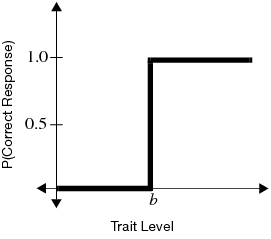
This figure shows that a person who has ability less than the value b has a 0% chance of getting the item correct. A person with trait level higher than b has a 100% chance of getting the item correct.
Of course, this is an unrealistic item, but it is illustrative in showing how a trait and a question probability relate to each other. More typical is a curve that allows probabilities that vary from zero to one. A typical curve found empirically is the S-shaped logistic function with a lower asymptote at zero and upper asymptote at one. It is markedly nonlinear. An example curve is shown in Figure 7.3.
Figure 7.3 Example Item Response Curve
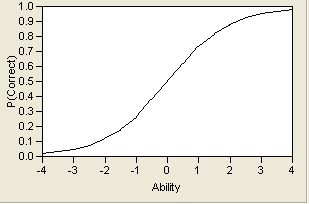
The logistic model is the best choice to model this curve, because it has desirable asymptotic properties, yet is easier to deal with computationally than other proposed models (such as the cumulative normal density function). The model itself is

In this model, referred to as a Three-Parameter Logistic (3PL) model, the variable a represents the steepness of the curve at its inflection point. Curves with varying values of a are shown in Figure 7.4. This parameter can be interpreted as a measure of the discrimination of an item—that is, how much more difficult the item is for people with high levels of the trait than for those with low levels of the trait. Very large values of a make the model practically the step function shown in Figure 7.2. It is generally assumed that an examinee will have a higher probability of getting an item correct as their level of the trait increases. Therefore, a is assumed to be positive and the ICC is monotonically increasing. Some use this positive-increasing property of the curve as a test of the appropriateness of the item. Items whose curves do not have this shape should be considered as candidates to be dropped from the test.
Figure 7.4 Logistic Model for Several Values of a
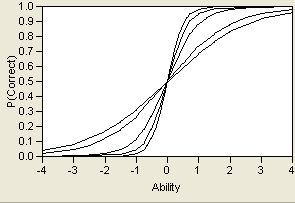
Changing the value of b merely shifts the curve from left to right, as shown in Figure 7.5. It corresponds to the value of θ at the point where P(θ)=0.5. The parameter b can therefore be interpreted as item difficulty where (graphically), the more difficult items have their inflection points farther to the right along their x-coordinate.
Figure 7.5 Logistic Curve for Several Values of b
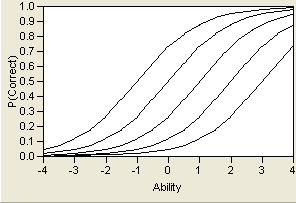
Notice that
and therefore c represents the lower asymptote, which can be nonzero. ICCs for several values of c are shown graphically in Figure 7.6. The c parameter is theoretically pleasing, because a person with no ability of the trait might have a nonzero chance of getting an item right. Therefore, c is sometimes called the pseudo-guessing parameter.
Figure 7.6 Logistic Model for Several Values of c
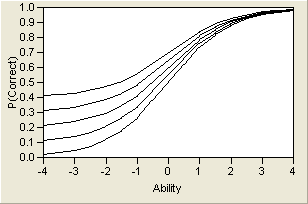
By varying these three parameters, a wide variety of probability curves are available for modeling. A sample of three different ICCs is shown in Figure 7.7. Note that the lower asymptote varies, but the upper asymptote does not. This is because of the assumption that there might be a lower guessing parameter, but as the trait level increases, there is always a theoretical chance of 100% probability of correctly answering the item.
Figure 7.7 Three Item Characteristic Curves
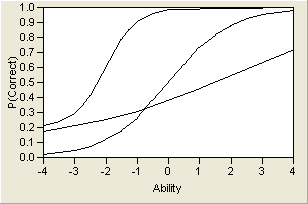
Note, however, that the 3PL model might by unnecessarily complex for many situations. If, for example, the c parameter is restricted to be zero (in practice, a reasonable restriction), there are fewer parameters to predict. This model, where only a and b parameters are estimated, is called the 2PL model.
Another advantage of the 2PL model (aside from its greater stability than the 3PL) is that b can be interpreted as the point where an examinee has a 50% chance of getting an item correct. This interpretation is not true for 3PL models.
A further restriction can be imposed on the general model when a researcher can assume that test items have equal discriminating power. In these cases, the parameter a is set equal to 1, leaving a single parameter to be estimated, the b parameter. This 1PL model is frequently called the Rasch model, named after Danish mathematician Georg Rasch, the developer of the model. The Rasch model is quite elegant, and is the least expensive to use computationally.
Caution: You must have a lot of data to produce stable parameter estimates using a 3PL model. 2PL models are frequently sufficient for tests that intuitively deserve a guessing parameter. Therefore, the 2PL model is the default and recommended model.
Launch the Item Analysis Platform
For example, open the sample data file MathScienceTest.jmp. These data are a subset of the data from the Third International Mathematics and Science Study (TIMMS) conducted in 1996.
To launch the Item Analysis platform, select Analyze > Consumer Research > Item Analysis. This shows the dialog in Figure 7.8.
Figure 7.8 Item Analysis Launch Window
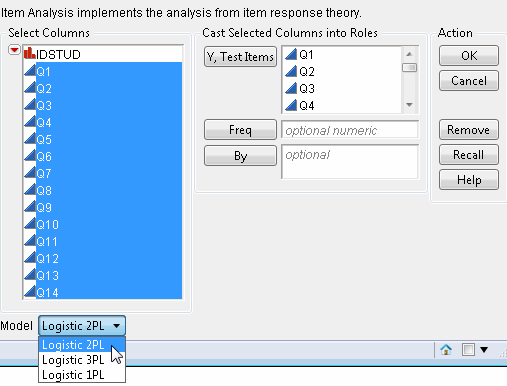
Y, Test Items
Are the questions from the test instrument.
Freq
Specifies a variable used to specify the number of times each response pattern appears.
By
Performs a separate analysis for each level of the specified variable.
Specify the desired model (1PL, 2PL, or 3PL) by selecting it from the Model drop-down menu.
For this example, specify all fourteen continuous questions (Q1, Q2,..., Q14) as Y, Test Items and click OK. This accepts the default 2PL model.
Special Note on 3PL Models
If you select the 3PL model, a dialog pops up asking for a penalty for the c parameters (thresholds). This is not asking for the threshold itself. The penalty that it requests is similar to the type of penalty parameter that you would see in ridge regression, or in neural networks.
The penalty is on the sample variance of the estimated thresholds, so that large values of the penalty force the estimated thresholds’ values to be closer together. This has the effect of speeding up the computations, and reducing the variability of the threshold (at the expense of some bias).
In cases where the items are questions on a multiple choice test where there are the same number of possible responses for each question, there is often reason to believe (a priori) that the threshold parameters would be similar across items. For example, if you are analyzing the results of a 20-question multiple choice test where each question had four possible responses, it is reasonable to believe that the guessing, or threshold, parameters would all be near 0.25. So, in some cases, applying a penalty like this has some “physical intuition” to support it, in addition to its computational advantages.
The Item Analysis Report
The following plots appear in Item Analysis reports.
Characteristic Curves
Item characteristic curves for each question appear in the top section of the output. Initially, all curves are shown stacked in a single column. They can be rearranged using the Number of Plots Across command, found in the drop down menu of the report title bar. For Figure 7.9, four plots across are displayed.
Figure 7.9 Component Curves
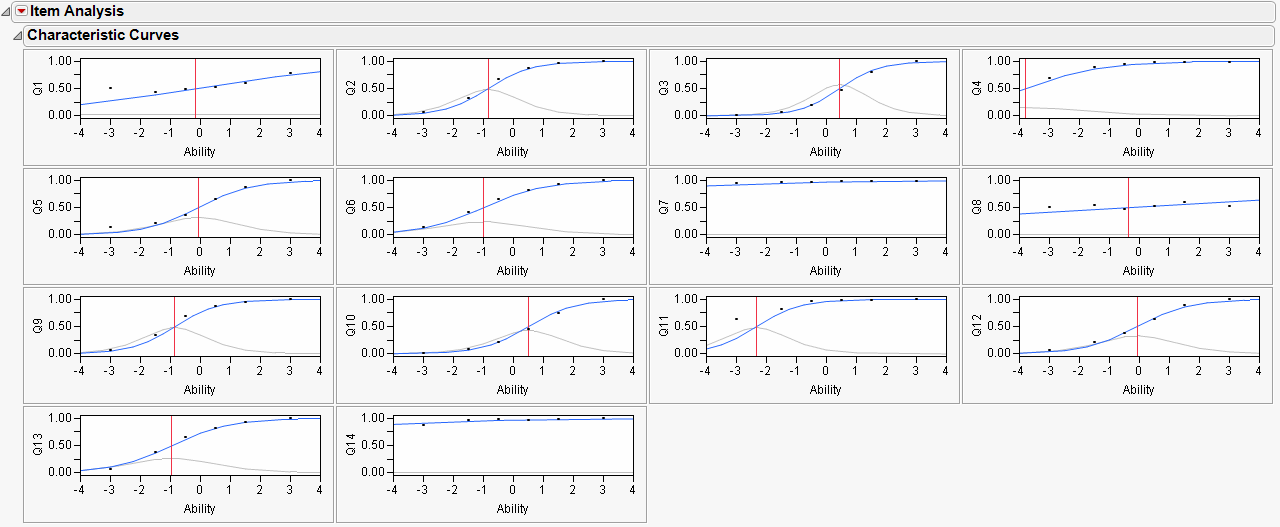
A vertical red line is drawn at the inflection point of each curve. In addition, dots are drawn at the actual proportion correct for each ability level, providing a graphical method of judging goodness-of-fit.
Gray information curves show the amount of information each question contributes to the overall information of the test. The information curve is the slope of the ICC curve, which is maximized at the inflection point.
Figure 7.10 Elements of the ICC Display
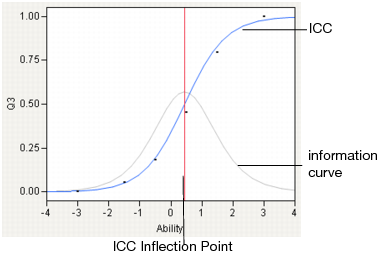
Information Curves
Questions provide varying levels of information for different ability levels. The gray information curves for each item show the amount of information that each question contributes to the total information of the test. The total information of the test for the entire range of abilities is shown in the Information Plot section of the report (Figure 7.11).
Figure 7.11 Information Plot

Dual Plots
The information gained from item difficulty parameters in IRT models can be used to construct an increasing scale of questions, from easiest to hardest, on the same scale as the examinees. This structure gives information about which items are associated with low levels of the trait, and which are associated with high levels of the trait.
JMP shows this correspondence with a dual plot. The dual plot for this example is shown in Figure 7.12.
Figure 7.12 Dual Plot
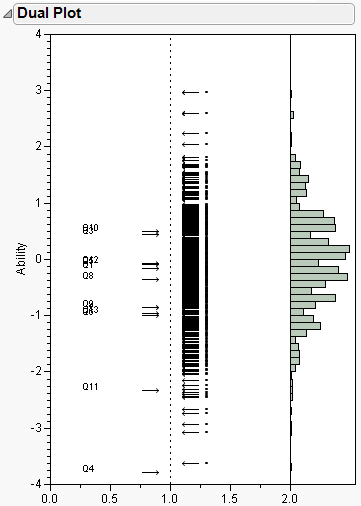
Questions are plotted to the left of the vertical dotted line, examinees on the right. In addition, a histogram of ability levels is appended to the right side of the plot.
This example shows a wide range of abilities. Q10 is rated as difficult, with an examinee needing to be around half a standard deviation above the mean in order to have a 50% chance of correctly answering the question. Other questions are distributed at lower ability levels, with Q11 and Q4 appearing as easier. There are some questions that are off the displayed scale (Q7 and Q14).
The estimated parameter estimates appear below the Dual Plot, as shown in Figure 7.13.
Figure 7.13 Parameter Estimates
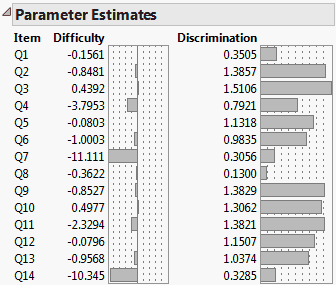
Item
Identifies the test item.
Difficulty
Is the b parameter from the model. A histogram of the difficulty parameters is shown beside the difficulty estimates.
Discrimination
Is the a parameter from the model, shown only for 2PL and 3PL models. A histogram of the discrimination parameters is shown beside the discrimination estimates.
Threshold
Is the c parameter from the model, shown only for 3PL models.
Item Analysis Platform Options
The following three commands are available from the drop-down menu on the title bar of the report.
Number of Plots Across
Brings up a dialog to specify how many plots should be grouped together on a single line. Initially, plots are stacked one-across. Figure 7.9 shows four plots across.
Save Ability Formula
Creates a new column in the data table containing a formula for calculating ability levels. Because the ability levels are stored as a formula, you can add rows to the data table and have them scored using the stored ability estimates. In addition, you can run several models and store several estimates of ability in the same data table.
The ability is computed using the IRT Ability function. The function has the following form
IRT Ability (Q1, Q2,...,Qn, [a1, a2,..., an, b1, b2,..., bn, c1, c2, ..., cn]);
where Q1, Q2,...,Qn are columns from the data table containing items, a1, a2,..., an are the corresponding discrimination parameters, b1, b2,..., bn are the corresponding difficulty parameters for the items, and c1, c2, ..., cn are the corresponding threshold parameters. Note that the parameters are entered as a matrix, enclosed in square brackets.
Script
Contains options that are available to all platforms. See Using JMP.
Technical Details
Note that P(θ) does not necessarily represent the probability of a positive response from a particular individual. It is certainly feasible that an examinee might definitely select an incorrect answer, or that an examinee might know an answer for sure, based on the prior experiences and knowledge of the examinee, apart from the trait level. It is more correct to think of P(θ) as the probability of response for a set of individuals with ability level θ. Said another way, if a large group of individuals with equal trait levels answered the item, P(θ) predicts the proportion that would answer the item correctly. This implies that IRT models are item-invariant; theoretically, they would have the same parameters regardless of the group tested.
An assumption of these IRT models is that the underlying trait is unidimensional. That is to say, there is a single underlying trait that the questions measure that can be theoretically measured on a continuum. This continuum is the horizontal axis in the plots of the curves. If there are several traits being measured, each of which have complex interactions with each other, then these unidimensional models are not appropriate.
..................Content has been hidden....................
You can't read the all page of ebook, please click here login for view all page.
